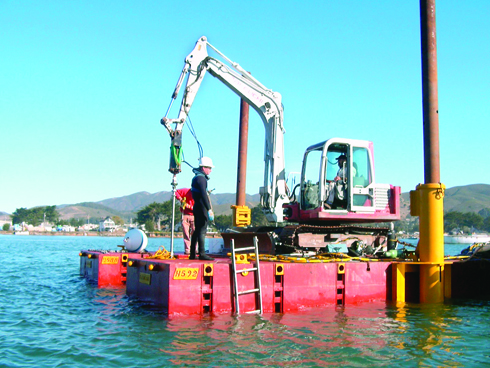
Now is the time of year that many mooring owners start investing in new equipment. As we prepare for our final report on mooring chains, I dove into some of our archival material on moorings to help guide people through the upgrade process.
There are plenty of variations in the details of permanent ground tackle, and PS has covered most, including mooring systems designed for sensitive seabeds. The standard rig is as follows: a mushroom anchor set well in the bottom (or a concrete block, but it had better be huge, or a screw-type anchor, which works well in hard bottoms), to which a length of heavy chainis shackled, then a swivel, then a length of somewhat lighter chain, a shackle, and a rope pendant that goes to the bow cleat. A mooring buoy is shackled to the top shackle. Some mooring ball designs let the upper chain run through their centers, with the pendant shackle resting on a steel lip at their top. Some newer designs, described below, even have a spot for storing a mooring pendant and pickup stick.
Some people put the swivel at the top of the operation, between the top chain and the mooring pendant, where it is easy to inspect. Others do away with the top chain altogether and replace it with rope. Some use two pendants. And so forth.
As for the proper length of the chains, opinions vary. Mike Muessel, owner of Oldport Marine in Rhode Island, has over 30 years experience installing and maintaining moorings. In the relatively deep, crowded, and protected confines of Newport Harbor, he uses a bottom chain a few feet longer than the depth of the water at high tide (the connection between top and bottom chains must be able to be inspected and replaced from a boat), and a top chain about 2.5 times the depth of the water. Others suggest a bottom chain twice the water depth. No one argues that more chain is better, both for the scope angle and because the heavy catenary of the suspended chain absorbs and dampens the pull of the boat. However, practicalities of swinging room, expense, and overkill intervene.
Some newer, elastic mooring-line products keep swinging radii small in light airs while still withstanding storm loads, but as marine surveyor Jonathan Klopman pointed out in response to our recent discussion of anchor rode elasticity, how much stretch is a good thing is a hot topic. Heat-induced friction in nylon rode, it seems, is on everybodys mind.

How to handle stretch and chafe in a mooring system raises several questions. Although three-stand nylon is the most economical option, more esoteric (and expensive) double-braid and plaited products are being marketed. At the high end of pendant products is New England Ropes cyclone mooring pendant. The pendant, set between the mooring ball and the boat, is made of two components-a length of low-stretch Endura 12 to handle abrasion on the boat and a high-grade nylon mooring pendant that goes from it to the mooring ball. Prices start in the triple digits; a frugal sailor should be able to achieve similar results for much less money with good chafe protection. In our original and follow-up chafe gear tests, products from Fjord consistently performed well.
Also missing from the picture is the all-important pick-up stick to attach to the mooring pendant, which boaters almost always supply themselves. If you are tired of getting fiberglass in your fingers from that old pick up stick, you might want to look at Dan Homans nearly indestructible Deluxe Pick-Up Stick. Homans company, Island Mooring Supplies, is also introducing a series of soft, hull-friendly mooring buoysdesigned to hold the pendant and the pick-up stick ready for the owner’s return-or for a new transient sailor to arrive.




































